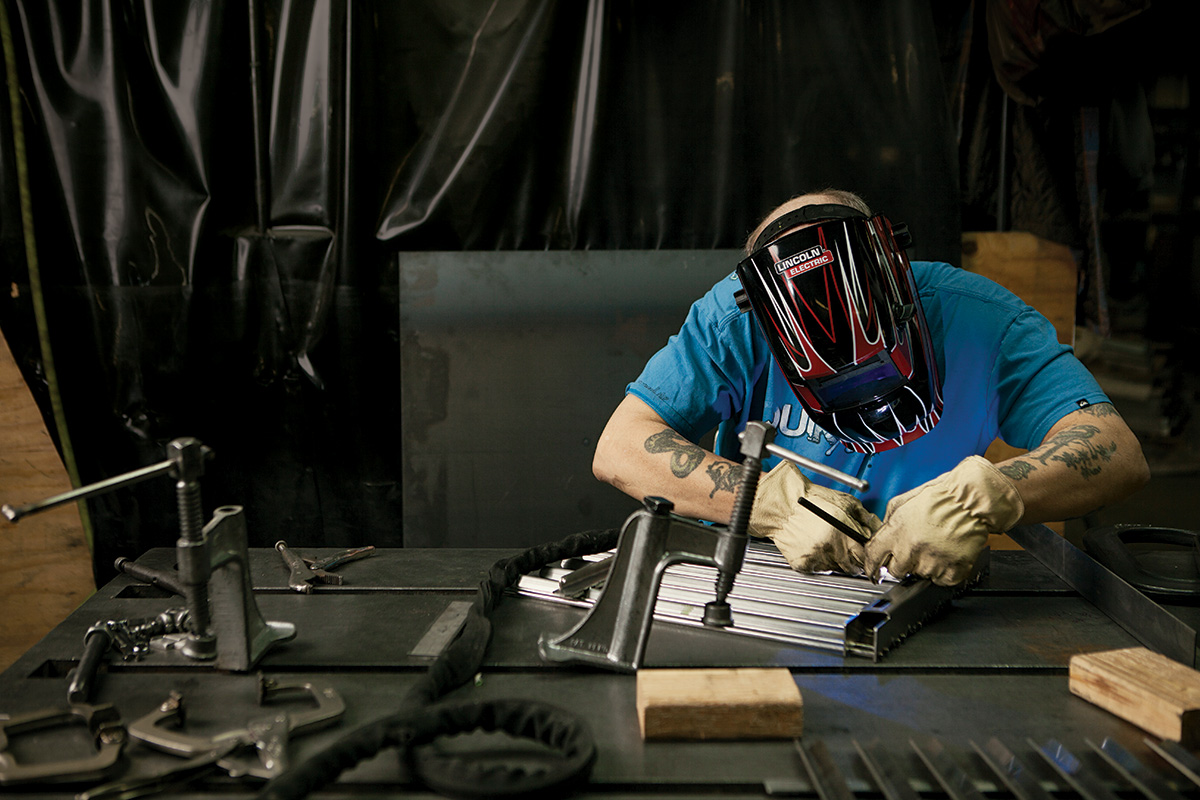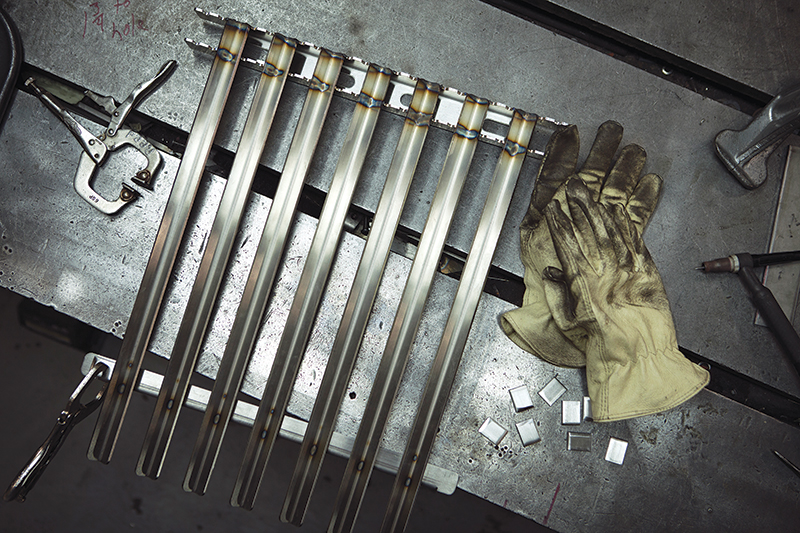Making Argentinian Grills for American Cooks
The secret to Argentinian grills? Simple grates positioned over a wood fire, a cooking method that allows for intense smoky flavors and very high heat.
Making Argentinian Grills for American Cooks
The secret to Argentinian grills? Simple grates positioned over a wood fire, a cooking method that allows for intense smoky flavors and very high heat.

When Time magazine sent foreign correspondent Charles Eisendrath to Paris in the 1960s and ’70s, he fell in love with the food. When the magazine gave him a post as bureau chief in Buenos Aires, he fell in love again, this time with the Argentinian tradition of grilling meat over an open fire.
But when Eisendrath returned to the United States, settling with his family in Michigan, he found his new home devoid of the flavorful jus of dishes served in France and the smoky heat of Argentinian wood-fired cooking. To fill the void, he developed a new kind of barbeque device called The Grillery.
Argentinian grills are straightforward affairs: simple grates positioned over a wood fire, a cooking method that allows for intense smoky flavors and very high heat. Eisendrath’s model, built with the help of local welders after more than a dozen designs, was a portable stainless-steel contraption that included a cooking grate with small drains to catch meat juices, and a crank to move the grate up and down for heat control. In the early 1980s, The Grillery made its debut at his dinner parties. Then friends began requesting their own. The buzz traveled, grills were sold and the company Grillworks was born. Company lore claims James Beard personally asked Eisendrath to show him a grill and then bought it on the spot.

The business moved along nicely for decades. It remained small, run by Eisendrath and his wife, Julia, who became default treasurer, bookkeeper and secretary all at once. Until 2006, when Eisendrath, who was working as a professor of journalism at the University of Michigan, decided to shut his hobby company down. That’s when his son Ben, who had grown up chopping wood for the family grills and recently left his job as a director at AOL, stepped in. “I couldn’t bear it, not being there,” says Ben.
His timing couldn’t have been better. In the past few years, Argentinian-style grilling has been gaining fans around the world, due in no small part to Francis Mallmann, an Argentinian chef. His 2009 cookbook, “Seven Fires: Grilling the Argentine Way,” extols the signature texture and taste of open-fire cooking and is effectively a love letter to flame.
“I am drawn to fire and the aroma of things cooking over wood,” writes Mallmann.
Cooking over wood fire can give meats a rich, distinctively smoky flavor and add intensity – and intimacy – to the act of cooking your food. Oliver Schwaner-Albright describes it in the New York Times: “as much a sport as an art – it’s more instinctive than cooking with a gas grill, more nuanced than cooking with charcoal, and more athletic than both.”
Ben Eisendrath in front of the Grillworks grill at Reynard.
Crankwheel used to raise and lower the cooking surface (and control cooking temperatures) on a Grillworks Infierno 64.
Jeremy Stanton, head of Fire Roasted Catering in Great Barrington, Massachusetts, designed and had built his own Argentinian-style grill – an infiernillo, or three-level steel grill with an open fire both above and below the cooking food – after seeing it in Mallmann’s book. “I love the look in people’s eyes when they come over and see what we do,” says Stanton. “You have so much heat and so much control, and the food is so beautiful. The quality of the heat and quality of the steel gives you this amazing crust that you can’t achieve on your home stove or your home grill.”
Mechanical engineer Gary Knackstedt started his grill-making company, NorCal Ovenworks, in 2011 near Sacramento, California. After designing and building a pizza oven in his garage, he decided he wanted an Argentinian grill. Unable to import the one he wanted, Knackstedt designed and then hired local welders to build his ideal grill.
“In America we have left cooking on the ground and cooking over a natural fire behind,” says Knackstedt. “Now we all cook on gas grills in the house. And so we pretty much lost the taste and smell of cooking over a fire.”
Knackstedt makes a selection of open-fire grills to order, priced between $1,800 and $5,000. He says he’s sold more than 780 to private residences and restaurants in two and a half years. His grills are popular with people who read the Mallmann book, and those who have visited Argentina, Chile and Uruguay. “They come back hungry for a taste of that kind of meat,” he says.
A welder grinds the back edge of a V-channel surface flush.
Reed, the production manager and master of stainless steel.
The Grillworks grill at Reynard in action.
When Ben took over his father’s company, he knew he had to scale the business. He first digitized his father’s hand-drawn designs and then found welders to make a few small grills, similar to his father’s models. They sold around 40 that first year.
Today, Grillworks makes between 200 and 300 grills a year. The freestanding residential models range in price from $2,850 to $12,675, with grill widths from 20 to 54 inches. Not to mention the built-in options, or the mega-size restaurant Infierno 96 model, which clocks in at around $40,000. “There’s always the ‘holy shit’ factor,” he says.
Ben splits his time between Washington, D.C., and New York City, fielding most calls for the company himself and working with potential customers on individual designs.
It hasn’t always been smooth. In 2008 Dan Barber, chef at Blue Hill at Stone Barns, called asking for a grill – a big one, one that could withstand the extreme use and heat of a high-functioning professional kitchen.
“I thought our grills were indestructible until we made one for Dan Barber,” says Ben, chuckling. “In home settings, our grills last generations. But Blue Hill used it so hard, they destroyed it in six months.” The Grillworks team remade the grill, factoring in the high wear and tear and heat, lining it with brick, working with the chefs’ needs. “The Infierno 96 is a result of Dan Barber ruining his.”
But it’s not only big names clamoring for his grills. In 2010, Ben received a letter from a soldier deployed in Afghanistan, asking if it would be possible to send grill parts abroad – he missed grilling. Ben’s response? “Screw it.” He decided to ship four whole grills to the soldier overseas. As we talk, Ben is sitting near one of his gargantuan wood-fired grills, built into the wall at Manhattan tapas restaurant Tertulia. Shifting a little in his seat, the grillmaker pulls out a metal coin emblazoned with a signet from the 20th Special Forces Airborne Group from his wallet and slides it across the table with a smile.
Follow us
This work is licensed under a Creative Commons Attribution-NoDerivatives 4.0 International License.
Want to republish a Modern Farmer story?
We are happy for Modern Farmer stories to be shared, and encourage you to republish our articles for your audience. When doing so, we ask that you follow these guidelines:
Please credit us and our writers
For the author byline, please use “Author Name, Modern Farmer.” At the top of our stories, if on the web, please include this text and link: “This story was originally published by Modern Farmer.”
Please make sure to include a link back to either our home page or the article URL.
At the bottom of the story, please include the following text:
“Modern Farmer is a nonprofit initiative dedicated to raising awareness and catalyzing action at the intersection of food, agriculture, and society. Read more at <link>Modern Farmer</link>.”
Use our widget
We’d like to be able to track our stories, so we ask that if you republish our content, you do so using our widget (located on the left hand side of the article). The HTML code has a built-in tracker that tells us the data and domain where the story was published, as well as view counts.
Check the image requirements
It’s your responsibility to confirm you're licensed to republish images in our articles. Some images, such as those from commercial providers, don't allow their images to be republished without permission or payment. Copyright terms are generally listed in the image caption and attribution. You are welcome to omit our images or substitute with your own. Charts and interactive graphics follow the same rules.
Don’t change too much. Or, ask us first.
Articles must be republished in their entirety. It’s okay to change references to time (“today” to “yesterday”) or location (“Iowa City, IA” to “here”). But please keep everything else the same.
If you feel strongly that a more material edit needs to be made, get in touch with us at [email protected]. We’re happy to discuss it with the original author, but we must have prior approval for changes before publication.
Special cases
Extracts. You may run the first few lines or paragraphs of the article and then say: “Read the full article at Modern Farmer” with a link back to the original article.
Quotes. You may quote authors provided you include a link back to the article URL.
Translations. These require writer approval. To inquire about translation of a Modern Farmer article, contact us at [email protected]
Signed consent / copyright release forms. These are not required, provided you are following these guidelines.
Print. Articles can be republished in print under these same rules, with the exception that you do not need to include the links.
Tag us
When sharing the story on social media, please tag us using the following: - Twitter (@ModFarm) - Facebook (@ModernFarmerMedia) - Instagram (@modfarm)
Use our content respectfully
Modern Farmer is a nonprofit and as such we share our content for free and in good faith in order to reach new audiences. Respectfully,
No selling ads against our stories. It’s okay to put our stories on pages with ads.
Don’t republish our material wholesale, or automatically; you need to select stories to be republished individually.
You have no rights to sell, license, syndicate, or otherwise represent yourself as the authorized owner of our material to any third parties. This means that you cannot actively publish or submit our work for syndication to third party platforms or apps like Apple News or Google News. We understand that publishers cannot fully control when certain third parties automatically summarize or crawl content from publishers’ own sites.
Keep in touch
We want to hear from you if you love Modern Farmer content, have a collaboration idea, or anything else to share. As a nonprofit outlet, we work in service of our community and are always open to comments, feedback, and ideas. Contact us at [email protected].by Molly Birnbaum, Modern Farmer
July 2, 2014
Modern Farmer Weekly
Solutions Hub
Innovations, ideas and inspiration. Actionable solutions for a resilient food system.
ExploreExplore other topics
Share With Us
We want to hear from Modern Farmer readers who have thoughtful commentary, actionable solutions, or helpful ideas to share.
SubmitNecessary cookies are absolutely essential for the website to function properly. This category only includes cookies that ensures basic functionalities and security features of the website. These cookies do not store any personal information.
Any cookies that may not be particularly necessary for the website to function and are used specifically to collect user personal data via analytics, ads, other embedded contents are termed as non-necessary cookies.
I would like a price list please.
looking forward to my subscription